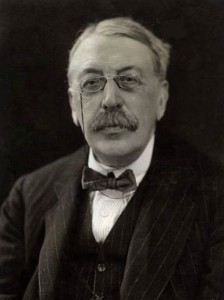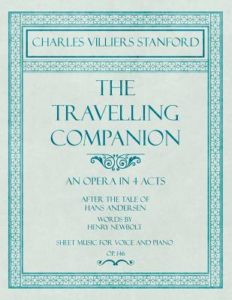Charles Villiers Stanford (1852- 1924) was one of the leading musicians of his generation and had a profound effect on the development and history of English music as a performer, conductor, composer, teacher and writer.
 Born in Dublin to a musical family, his musical gifts were recognized early. He studied piano and the violin privately and subsequently the organ with Robert Prescott Stewart at Christchurch and St. Patrick’s Cathedrals in Dublin. Stanford entered Queens’ College Cambridge in 1870 as both an organ and classics scholar. While still an undergraduate he became Assistant Conductor of the Cambridge University Music Society and held the position of Conductor from 1875 to 1893. He became organist at Trinity College Cambridge in 1873 and subsequently studied composition in Germany with Carl Reinecke and Friedrick Kiel.
Born in Dublin to a musical family, his musical gifts were recognized early. He studied piano and the violin privately and subsequently the organ with Robert Prescott Stewart at Christchurch and St. Patrick’s Cathedrals in Dublin. Stanford entered Queens’ College Cambridge in 1870 as both an organ and classics scholar. While still an undergraduate he became Assistant Conductor of the Cambridge University Music Society and held the position of Conductor from 1875 to 1893. He became organist at Trinity College Cambridge in 1873 and subsequently studied composition in Germany with Carl Reinecke and Friedrick Kiel.
He was appointed Professor of Composition at the Royal College of Music in London in 1883 (a position that he held for more than forty years) and Professor of Music at Cambridge in 1888. He subsequently held appointments as Conductor of the Bach Choir in London, the Leeds Philharmonic Society and the Leeds Festival.
 Stanford was a prolific composer, completing seven symphonies, eight string quartets, nine operas, more than 300 songs, 30 large scale choral works and a large body of chamber music. He also composed a substantial number of works for the organ, as well as anthems and settings of the canticles for the Anglican Church. He wrote extensively on music including three volumes of memoirs and a popular text on composition.
Stanford was a prolific composer, completing seven symphonies, eight string quartets, nine operas, more than 300 songs, 30 large scale choral works and a large body of chamber music. He also composed a substantial number of works for the organ, as well as anthems and settings of the canticles for the Anglican Church. He wrote extensively on music including three volumes of memoirs and a popular text on composition.
Today he is largely remembered for his songs and religious music as well as his influence on several generations of composition students at the Royal College of Music. These included Sir Arthur Bliss, Frank Bridge, Samuel Coleridge-Taylor, Rebecca Clarke, Ivor Gurney, Gustav Holst, Herbert Howells, John Ireland, Ralph Vaughan Williams and Charles Wood.
Stanford was knighted in 1902 and in 1904 he became the first British composer to be elected a member of the Royal Academy of Arts in Berlin. His ashes are interred in Westminster Abbey near the remains of Henry Purcell.
There has been a revival of interest in Stanford’s music over the past two decades with performances of some of his neglected works and an increasing number of recordings.
The Society’s Musical and Historical Advisor is Professor Jeremy Dibble of Durham University. Professor Dibble is the leading authority on Stanford’s life and music. His comprehensive biography of Stanford was published by the Oxford Press in 2002. He has edited and prepared many of Stanford’s scores for performance. In 2012 he orchestrated Stanford’s short score of the Second Violin Concerto ( Opus 162). This was premiered in Durham Cathedral at a Stanford Society Festival Weekend in March 2012 with Rupert Marshall-Luck as soloist. The work has subsequently been recorded by EM Records (EMR CD023).
